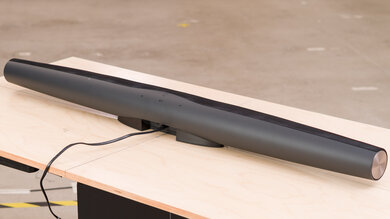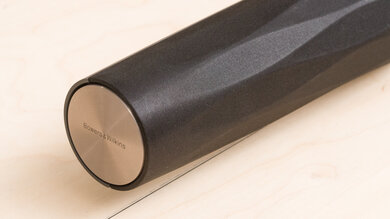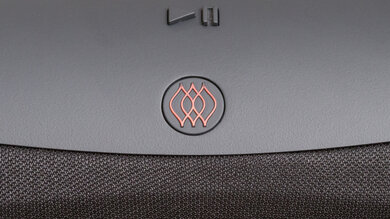The Bowers & Wilkins Formation Bar is a 3.0 setup. This premium soundbar has a very stylish design, and you can upgrade it down the line with a Formation subwoofer and satellite speakers. Its sound profile is pretty neutral, but there's a noticeable lack of thump and rumble in the low-bass, especially when watching movies. It also doesn't have any HDMI connections, which is pretty disappointing for such a high-end setup. It doesn't support object-based and lossless audio formats like Dolby Atmos or DTS:X. With no remote and a limited selection of physical controls on the bar, you also need to use its apps to control most of its features.
Our Verdict
The Bowers & Wilkins Formation Bar is fair for mixed usage. Its sound profile out-of-the-box is fairly neutral, with some extra muddiness in the high-bass that can slightly thin out vocals and lead instruments and a touch of extra brightness in the treble. You can notice the lack of low-bass in bass-heavy music and action-packed movies, though. Movie fans are also likely to be disappointed by the lack of Dolby Atmos support and its poor surrounds performance.
-
Gets loud.
-
Bass and treble adjustments.
-
Stylish design.
-
Lacks low-bass.
-
Limited selection of sound enhancement features.
-
No HDMI connections.
The Bowers & Wilkins Formation Bar is okay for dialogue-centric content like TV shows. This 3.0 setup has a discrete center channel that anchors voices to a pinpoint location in the soundstage, so you feel more immersed in your audio. However, there aren't any dialogue enhancement or night mode features to help improve the quality of dialogue. While there are a lot of wireless playback options to help you stream podcasts to the bar, we had some issues connecting via Bluetooth and Apple AirPlay 2.
-
Gets loud.
-
Limited selection of sound enhancement features.
The Bowers & Wilkins Formation Bar is decent for music. Its sound profile out-of-the-box is fairly neutral, with some extra muddiness in the high-bass that can slightly thin out vocals and lead instruments and a touch of extra brightness. Without a subwoofer, it struggles to reproduce the deep thump and rumble in the low-bass, so it's not ideal for fans of bass-heavy genres like EDM. There are some bass and treble adjustments to help you customize its sound, but unfortunately, it lacks a full graphic EQ.
-
Gets loud.
-
Bass and treble adjustments.
-
Lacks low-bass.
-
Limited selection of sound enhancement features.
The Bowers & Wilkins Formation Bar is middling for movies. There's no support for Dolby Atmos or DTS content. Also, it has to downmix surround content into stereo, which doesn't sound very immersive. While the dialogue is reproduced fairly clearly, there's a noticeable lack of low-bass, especially when you're watching action-heavy scenes in movies. On the upside, it does get pretty loud.
-
Gets loud.
-
Bass and treble adjustments.
-
Lacks low-bass.
-
Limited selection of sound enhancement features.
-
No HDMI connections.
- 6.5 Mixed Usage
- 6.8 Dialogue/TV Shows
- 7.2 Music
- 5.8 Movies
- Updated Nov 17, 2021: Review published.
- Updated Nov 11, 2021: Early access published.
- Updated Oct 22, 2021: Our testers have started testing this product.
- Updated Oct 20, 2021: The product has arrived in our lab, and our testers will start evaluating it soon.
- Updated Oct 16, 2021: We've purchased the product and are waiting for it to arrive in our lab.
- Updated Oct 13, 2021: The product has won our suggestion poll, so we'll buy and test it soon.
Differences Between Sizes And Variants
This soundbar is available in 'Black', and you can see the label for the model we tested here.
If you come across another version of this soundbar, let us know in the discussions, and we'll update our review.
Compared To Other Soundbars
The Bowers & Wilkins Formation Bar is a very premium 3.0 soundbar that can be upgraded down the line with a subwoofer and satellites. Despite its high-end price, it lacks HDMI connections, and it doesn't support any object-based or lossless audio formats like DTS:X or Dolby Atmos. There's also a very limited selection of sound enhancement features to choose from.
See also our recommendations for the best soundbars, the best soundbars for music, and the best soundbars for movies.
The Sonos Arc is better than the Bowers & Wilkins Formation Bar. The Sonos is a 5.0.2 setup that's better built. Unlike the Bowers & Wilkins, it has Dolby Atmos support and an HDMI ARC port. Its soundstage, center, and surround performances are better, and it offers more sound enhancement features. That said, it isn't Bluetooth-compatible like the Bowers & Wilkins.
The Bose Smart Soundbar 900 is a better standalone option than the Bowers & Wilkins Formation Bar. The Bose is a better-built 5.0.2 setup that supports Dolby Atmos content and has better soundstage and surround performances. Also, it comes with HDMI connections, unlike the Bowers & Wilkins.
The Sonos Beam (Gen 2) is better than the Bowers & Wilkins Formation Bar. The Sonos is a 5.0 setup with Dolby Atmos support. It has better soundstage and surround performances, and there are more sound enhancement features available such as room correction. Also, unlike the Bowers & Wilkins, it has HDMI connections.
The Samsung HW-Q950A is better than the Bowers & Wilkins Formation Bar. The Samsung is an 11.1.4 setup with a dedicated sub and satellites. Unlike the Bowers & Wilkins, it supports Dolby Atmos content and has HDMI inputs. It can reproduce a more extended low-bass, and it has better soundstage, center, and surround performances. There are also more sound enhancement features, like room correction. That said, some users may prefer the Bowers & Wilkins' standalone design.
The Sonos Playbar is better than the Bowers & Wilkins Formation Bar. The Sonos is better built with better soundstage and center channel performances. It also offers more sound enhancement features to customize its sound. However, the Bowers & Wilkins does offer more wireless playback options, including Bluetooth.
The Bose Smart Soundbar 300 is better than the Bowers & Wilkins Formation Bar. The Bose is better built and offers a better center channel performance. It even comes with some extra sound enhancement features, including dialogue enhancement, as well as an HDMI ARC port.
Test Results
You can purchase a Formation Bass subwoofer from the manufacturer separately.
The manufacturer also sells Formation satellites separately. You can choose between speakers like the Formation Duo, the Formation Wedge, and the Formation Flex.
The back of the bar is made of plastic. There's an opening for the inputs and the power cable. You can also mount it to your wall using the included proprietary mounting plate. First, you need to unscrew the plastic base, and then you can attach the mounting plate to the bar.
The Bowers & Wilkins Formation Bar has a good build quality. The back side of the bar is made of plastic, which feels quite solid and durable, and there are metal plates on the ends of the bar. While the fabric covering the front seems quite premium, it's also a bit loose. It seems like it could tear easily, especially if you press too hard on the fabric. Also, the bar gets pretty warm, even if you only use it for a few minutes.
The Bowers & Wilkins Formation Bar has a decent stereo frequency response. Its frequency response is somewhat neutral, with some extra muddiness in the high-bass that can thin out vocals and lead instruments, and a touch of extra brightness in the treble. It struggles to reproduce low-bass, so you don't feel the deep thump and rumble in bass-heavy music or action-packed movies. In our subjective listening tests, the lack of low-bass was very evident. We felt that the bar sounds pretty neutral overall, but it lacks extra feeling and richness compared to other premium bars such as the Bose Smart Soundbar 900.
There are bass and treble adjustments to help you customize its sound. However, if you prefer a neutral sound profile, we recommend using this soundbar with its default settings.
This soundbar has a decent stereo soundstage. The soundstage is perceived to be a bit smaller than the bar itself, which can be disappointing for listeners who want to feel like audio is coming from all around them. That said, it has good focus, so sound objects seem to come from an accurate, pinpoint location rather than a more generalized area.
The Bowers & Wilkins Formation Bar has very good stereo dynamics. This soundbar gets pretty loud, so it's suitable for listening to music in large rooms and at crowded parties. However, there's some compression when you push it to max volume that can impact the sound quality.
The Bowers & Wilkins Formation Bar has a great stereo THD performance. At a normal listening volume, THD falls within good limits, meaning audio reproduction is clean and pure. While there's a jump in THD across the range at max volume, this may not be too noticeable to most listeners with real-life content.
The Bowers & Wilkins Formation Bar has a good center channel performance. This 3.0 setup offers a discrete center channel, so voices are anchored to a pinpoint location in the soundstage. Dialogue can seem muddy, however, and it can also sound a bit bright.
The Bowers & Wilkins Formation Bar has a poor surround performance. This 3.0 setup has to downmix surround content into stereo to play it. However, this doesn't reproduce surround objects as clearly and accurately as a discrete setup. Audio seems like it's coming from in front of you rather than from speakers placed all around you. Also, you don't feel the low rumble in the bass during action-packed scenes.
For a standalone bar with Atmos support, check out the Bowers & Wilkins Panorama 3.
This bar has a terrible selection of sound enhancement features. There are bass and treble adjustments so you can customize its sound, but it lacks more premium features like a graphic EQ or room correction. For a premium bar with more sound enhancement features, check out the Samsung HW-Q950A.
There's a very limited selection of physical inputs. You can plug it into your TV with the included optical cable, but it lacks HDMI connections, so it can't send lossless and object-based audio formats like Dolby Atmos or DTS:X. There's also an ethernet port and a USB port for servicing the bar.
This soundbar only supports Dolby Digital content via optical. While this common surround sound format is used on many Blu-rays and streaming platforms, unfortunately, there's no DTS support.
This soundbar has a decent latency performance. Its latency via Optical is fairly high, so you can notice a delay between the video you see and the audio you hear, especially with lip-syncing. That said, some apps and TVs can compensate for latency differently, so your real-world experience can vary.
The Bowers & Wilkins Formation Bar supports lots of wireless playback options. However, during our testing, we had some issues connecting the bar via Bluetooth. Its setup isn't very intuitive since you need to use the Formation app for the setup. Also, we had to reset the bar to get it to connect via Bluetooth. Some other users report a similar issue with Bluetooth connectivity here. There was also a noticeable difference in audio quality when listening to music via Spotify over Apple AirPlay 2. The quality improved when we listened to the same songs on YouTube.
This soundbar is also advertised to support Spotify Connect, and it's Roon Ready, which is handy for listeners who use these music services.
The Bowers & Wilkins Formation Bar doesn't have a remote, which might disappoint some users. Since there aren't any HDMI connections on the bar, you also can't use HDMI CEC to control the bar with your TV remote. The manufacturer says that you can use the Formation app to program IR TV remote control, but it might not work with all TVs. In our tests, we weren't able to connect the remote from our Samsung HW-Q80T TV.
This soundbar doesn't have built-in voice assistant support. The manufacturer says that you can pair it with a third-party Amazon Alexa device to control the bar using your voice.
You need to use two different apps to get this soundbar to work properly. First, the Bowers & Wilkins Formation app lets you connect the soundbar to Wi-Fi, set up Amazon Alexa with a third-party device, and activate IR remote control. It also has bass and treble adjustments so you can control the bar's sound, and it even lets you update the bar's firmware. However, if you want to control the bar's volume, you need to download the Bowers & Wilkins Music app. This app also gives you access to different music services that you can stream to the bar.
Like many users, we find it very inconvenient that we're only able to control the bar via the app. There are also many reports of glitches on the app, especially after updating the bar's firmware. You can see some examples of these reports in the comments here.
This soundbar goes into standby mode after 20 minutes of inactivity, and you can wake it up by pressing the Formation button. There's no HDMI CEC, but you can program IR TV remote control via the app. That said, it may not work with all TVs.













